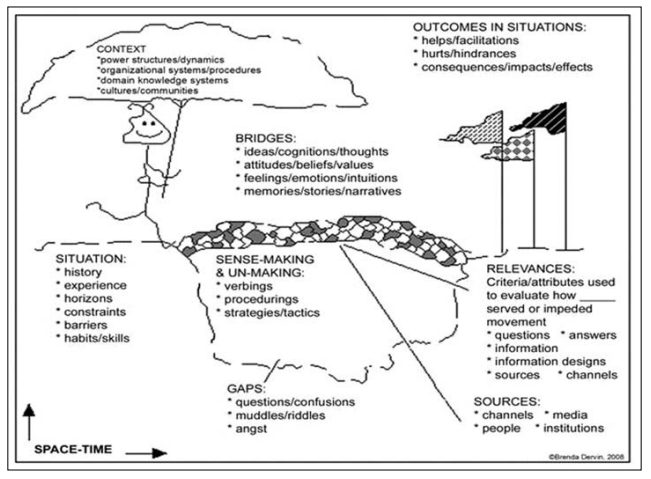Distinction between information behaviour and information practice
- Behaviour: how we search (e.g. type in a short query, click top result, etc.)
- Practice: search as conditioned by social and technical norms and practices
A combination of information retrieval, information encountering, information avoidance, etc. Methods of interacting with information
A model is a simplified, tentative representation of a phenomenon of interest, often depicted as a graphic. A model describes important factors (variables) and proposes their relationships (associations).
Information Seeking Behaviour
Dervin’s Sense-making Model

Knowledge ‘is the sense made at a particular point in time-space by someone’
Information seeking is conceptualized as a gap-bridging process in which the individual makes moves, influenced by information, in time and space to reach a desired outcome or goal to make sense of a ever-gappy ‘reality’
In this model, an information object is not seen simply as an entity that meets or is relevant to an information need. Rather, information embedded in an information object must be conceptualized by the individual in a particular situation in order to influence actions.
11 Deadliest Sins of Knowledge Management
Fahey and Prusak (1998)
- Not developing a working definition of knowledge.
- Emphasizing knowledge stock to the detriment of knowledge flow.
- Viewing knowledge as existing predominantly outside the heads of individuals.
- Not understanding that a fundamental intermediate purpose of managing knowledge is to create shared context.
- Paying little heed to the role and importance of tacit knowledge.
- Disentangling knowledge from its uses.
- Downplaying thinking and reasoning.
- Focussing on the past and the present and not the future.
- Failing to recognize the importance of experimentation.
- Substituting technical contact for human interface.
- Seeking to develop direct measures of knowledge.